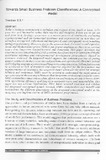Please use this identifier to cite or link to this item:
http://hdl.handle.net/10311/190Full metadata record
| DC Field | Value | Language |
|---|---|---|
| dc.contributor.author | Temtime, ZT | - |
| dc.date.accessioned | 2008-08-04T10:41:23Z | - |
| dc.date.available | 2008-08-04T10:41:23Z | - |
| dc.date.issued | 2005-11 | - |
| dc.identifier.citation | Temtime, ZT (2005) Towards small business problem classification: a conceptual model / BIAC Journal Vol 2, Issue 2, pp 1-14 | en |
| dc.identifier.issn | 1729-1070 | - |
| dc.identifier.uri | http://hdl.handle.net/10311/190 | - |
| dc.description.abstract | Today's business environment is turbulent and requires firms, small or large, to be proactive and innovative rather than reactive and receptive if they are to survive and grow in it. Strategic awareness is a mental process of continually evaluating organisational and environmental problems and improvement on how they are identified, recognised, influenced and interpreted and consequently used in making managerial decisions. However, due to the apparent lack of resources and expertise, Small and Medium Enterprises (SMEs) put greater emphasis on short-term survival issues that long-term competitiveness and dynamism. This paper develops and examines a conceptual model of SME problem classification for designing meaningful assistance schemes and entrepreneurial development programmes. .. | en |
| dc.language.iso | en | en |
| dc.publisher | Botswana Institute of Administration and Commerce | en |
| dc.subject | Business problem classification | en |
| dc.subject | Small and medium enterprises (SMEs) | en |
| dc.title | Towards small business problem classification: a conceptual model | en |
| dc.type | Article | en |
| Appears in Collections: | Research articles (Dept of Management) Economic diversification and entrepreneurship | |
Files in This Item:
| File | Description | Size | Format | |
|---|---|---|---|---|
| temtime_BIAC_2005.pdf | 2.68 MB | Adobe PDF |  View/Open | |
| license.txt | 1.95 kB | Text | View/Open |
Items in DSpace are protected by copyright, with all rights reserved, unless otherwise indicated.
